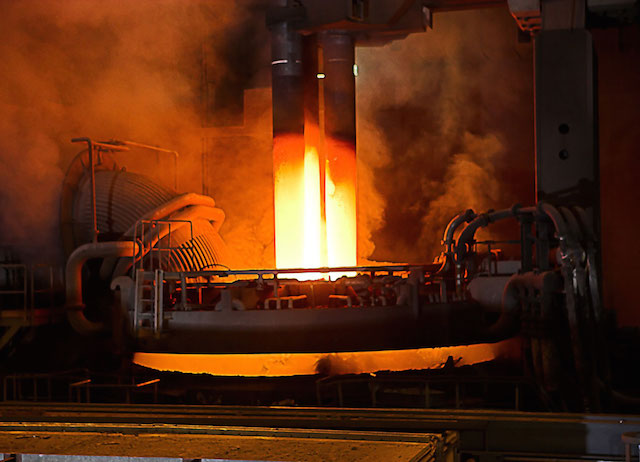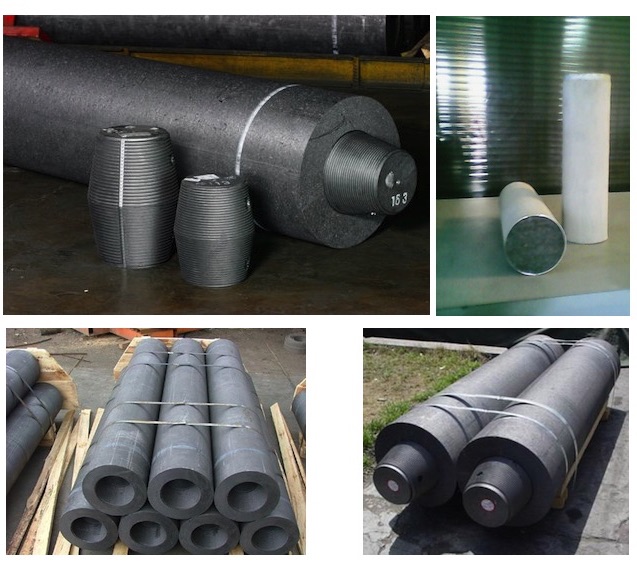
Graphite Electrodes
Graphite electrodes are used mainly in electric arc furnace steel production. Furthermore, coatings has been used on graphite electrodes since 1969 in these industries for steel melting, ranging from 5 tonnes to 185 tonnes capacity, using 200 ~ 600 mm diameter electrodes. Graphite electrodes are used for producing STEEL.
The coating has two main functions :

Coated Graphite Electrode
The best way to perceive the effect of coating is when coated and uncoated electrodes are mixed on the same electrode column.
KANDI sophisticated Coating gives excellent antioxidation properties to graphite electrodes and reduces the specific consumption of graphite considerably. Coated electrodes are used for the production of electric steel as well as for manufacturing non-metallic products in electric arc processing.
The protective coating consists of several layers and is added to the electrode surface in a complicated, multilevel production process. A special characteristic of the coating technology is the electric arc treatment of every single layer. Indicative coating details :-
| Parameter | Unit | Value |
| Thickness of the Coating | mm | 0,5 – 0,8 |
| Specific Electrical Resistivity | Ω.µm | 0,07 – 0,10 |
| Gas impermeability at 900° C | h | above 50 |
| Temperature when Decomposition Process starts | °C | above 1850 |
| Delay of Graphite Surface Oxidation | h | 10 – 20 |
Coating consists of 3 layers serving separate function. The first layer produces a high temperature, oxidation resistant coating, which forms the major protection of the electrode. Above this layer, a sprayed coat helps to nullify any porosity of the previous coating layer. The final layer is mainly responsible for the increase in conductivity. The coating withstands temperatures over 1850 deg C and chemically destroyed only after many hours in the furnace. It is relatively impermeable to gas, and being semi-fluid high aluminium layer, resistant to thermal shock.
The degree of oxidation is determined by measuring the carbon monoxide and carbon dioxide present in waste gases extracted during the heating of samples in an oxidising gas stream. At temperatures between 1000 ~ 1850 deg. C found in arc furnace, the uncoated graphite samples yield large amounts of CO & CO2. By contrast, at 1000˚ C, the coated samples produce no CO or CO2, and even after some time at 1850 deg. C, no CO and only 2~5% of CO2 is found. The electrical resistance is reduced ( and hence conductivity increased ) by the application of coating. Laboratory tests have shown the coating itself to have an electrical resistance of 14.50-22.00µ ohm cm against that of graphite of 600~1000 µ ohm cm.
| Nominal Diamter | Typical Diameter | Diameter Tolerances | Nominal Length | ||||
| mm | mm | Max mm |
Min mm |
mm | mm | mm | mm |
| 350 | 356 | 358 | 352 | 1800 | 2100 | ||
| 400 | 406 | 409 | 403 | 1800 | 2100 | 2400 | |
| 450 | 457 | 460 | 454 | 1800 | 2100 | 2400 | |
| 500 | 508 | 511 | 505 | 1800 | 2100 | 2400 | 2700 |
| 550 | 559 | 562 | 556 | 2100 | 2400 | 2700 | |
| 600 | 610 | 613 | 607 | 2100 | 2400 | 2700 | |
Note: special diameters and / or length on request
Kandi Engineering was incorporated in 1982, and started initial trading activities at Manor (Maharashtra), an Industrial Area just 85 kms from Mumbai, INDIA. Cost saving and good quality being the motto of the management, the production started in 1995 for manufacture of industrial products related to Steel & Metallurgical Industry.
Read More